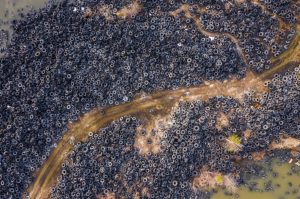By Alex Bowles, a member of the Transition to Zero Pollution cohort.
My work is focussed around decarbonising society through the enhanced recovery of waste materials. The UK produces 600,000 tonnes of waste tyres per year and in 2018 over half were exported to developing nations such as India (Source: UN Comtrade), where they are burnt in brick kilns or converted to oil in systems with negligible environmental and safety standards.
I am working on developing pyrolysis (heating in the absence of oxygen) as an upcoming waste-recovery technique for these tyres. Pyrolysis can be used to treat any organic waste material, such as biomass, plastics and rubber, to produce a mixture of solid (char), liquid (pyro-oil) and gas (syngas) products. The liquid and gas can be combusted for energy recovery or converted into recycled chemicals. Recycling mechanisms for the solid pyrolysis char product are still developing. I work on developing this pyro-char into activated carbon, a material used to filter air and water.

In my lifetime, atmospheric CO2 has risen by 15%. Abatement of further CO2 emissions to prevent catastrophic climate change is the biggest challenge facing humankind. My PhD focusses on utilising this recycled pyro-char derived activated carbon as a CO2 adsorbent, which can be attached to the end of a fossil fuelled power plant, cement kiln or factory that uses industrial heat to capture the CO2 through a carbon-capture mechanism. This system would prevent the release of CO2 into the atmosphere. Preliminary experiments have shown the potential to capture CO2 quantities of over 10% of the weight of the carbon reversibly and rapidly.

I am working closely with my PhD sponsor, Pyrenergy, to develop pyrolysis as an effective recovery process for waste tyres. Much of the pyro-char feedstock for my PhD is a product of the Pyrenergy industrial process. Tyres are an especially challenging waste material due to the a) heterogeneity between brands and parts of a tyre, b) complex chemistry of rubber, c) high energy of production, and d) their abundance (>2 billion tyres are produced every year). I am working to contribute to the improved recovery of this important resource, which would support circular economy principles whilst reducing waste (tyre) and atmospheric (CO2) pollution to the environment.